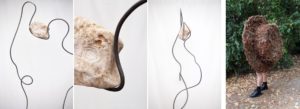A new generation of artists committed to the environment is emerging in France.
Our editorial team proposes to explore four major trends within this young committed scene, from the 21 winners of the Planète Art Solidaire support awarded by Art of Change 21 (editor of this blog), sponsored by Maison Ruinart.
See also other trends:
The Scientific Auxiliaries
The Anthropologists of the Common Good
The Anthropocene Composters
A new movement of young artists engaged in the environment is bringing a new use of materials in art, not hesitating to prefer them alive or useful for the living (e.g. composable). Inventing new rituals, they are creating a new ecological paganism, where eating, planting or walking offers humans a more just, spiritual, joyful, and carnal relationship between themselves and the living. By promoting reconnection between humans and non-humans and advocating “care” at the heart of this relationship, these artists are renewing a long tradition of seeking balance but also innovation, two dynamics now needed to lead to a more sustainable world.
Côme Di Meglio views his art as a spiritual adventure, activating our capacity to establish relationships with the living world. His work takes the form of installations, sculptures, performances and, since 2018, the TransitionFOOD dinners, which approach the essential act of eating as a symbol of our relationship with the environment. He is currently working on an architectural project inspired by biomimicry, using mycelium to create a relational work that by using living materials will eventually be returned to the earth.

Chloé Jeanne works from and with the living world and creates biomaterials. Her sculptures and installations focus on natural processes that question our conception of material, temporality, scale and space. She brings us back to nature and questions our relationship with the environment. By cultivating her own materials, like scoby, mycelium and crystals, Jeanne places the notion of laissez faire at the heart of her artistic practice and pushes the creative role of the artist further in the making of a work.
Vincent Laval approaches his work as an “artist-walker-gatherer”. The chestnut branches used in his sculptures are not chosen at random. For Plus loin dans la forêt (Further into the forest), the artist only uses those which have fallen to the ground and which time has rendered rot-proof. Finding them requires great patience, several weeks of crisscrossing and searching… As a result, walking, time, observation and knowledge of the forest landscape become an integral part of the final sculpture.
Anaïs Tondeur proposes new ways of inhabiting the Earth through steps, photographic installations, videos and drawings. This fairer vision of cohabitation with non-humans calls upon a multidisciplinary approach, based on collaborations with researchers in anthropology, philosophy, geology and ecology. Her new installation and performance project intends to promote the growth of seeds born from the irradiated soils of Chernobyl, a continuation of her artistic project started ten years ago on plants from the Chernobyl Exclusion Zone.

Wiktoria Wojciechowska creates artworks, photographs, videos, and sculpted objects that re-establish connections between humankind and nature. The artist offers ritual-like performative experiences, inviting us to feel the energy and power of plants and stone. She wishes to compile the interactions resulting from her work in a library of traces. Her series imprint – sculpture is activated by the viewer, who can touch and move the pieces.
From drawing to sculpture and in situ installations, the work of Florian Mermin evokes natural settings that activate our five senses. He uses simple or repurposed materials such as pine branches or dead leaves to remind us of our sensitivity to the environment. In his artistic work, nature is represented as a place of dreams, wonderment and fear.

Alice Audouin and Pauline Lisowski
June 2021
Photo credits :
Côme Di Meglio, MycoTemple, dôme en mycelium, carton et sciure recyclés, en collaboration avec Mycotopia, dimensions 600 x 300 x 300 cm / Anaïs Tondeur, Pétrichor, installation, vidéo HD, couleur, 14” alambic, 56 distillations de terre, collaboration avec l’anthropologue Germain Meulemans, 2016-19 / Wiktoria Wojciechowska, Imprint, face, calcaire et traces fossiles, Oise, France, acier, 170x50x50 cm, 2020 / Florian Mermin, La Promenade, sculpture performative, branches de sapin, carton 130 x 130 x 40 cm, 2020 / Chloé Jeanne, Chardons, lanternes chinoises, plâtre, enduit et colorant alimentaires, dimension entre 60 cm et 10 cm de diamètre, 2017-2018 / Vincent Laval,Cabane, châtaigner 210 x 300 x 200 cm, 2019, ©Jean-Baptiste Monteil
Find all the articles from Impact Art News n°31 – June 2021
To subscribe to Impact Art News (free) : here

